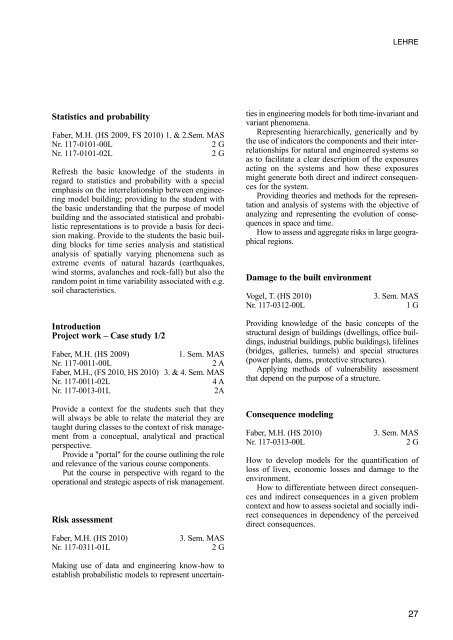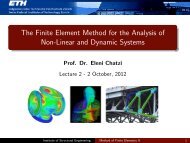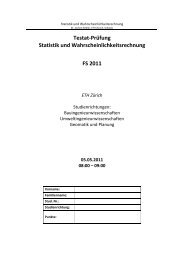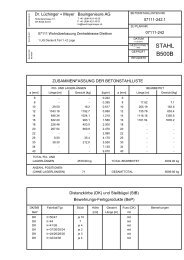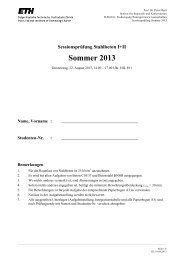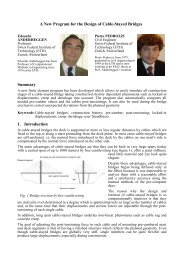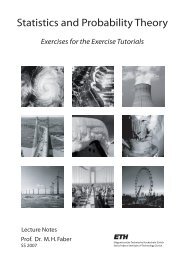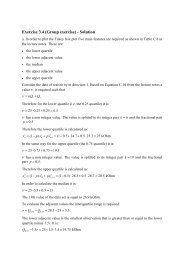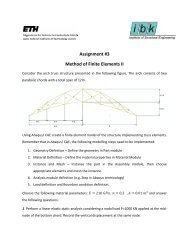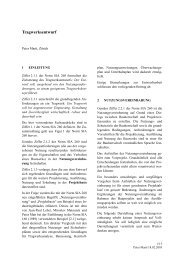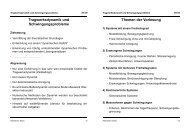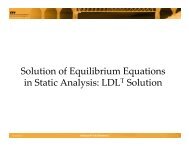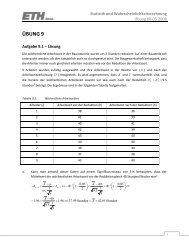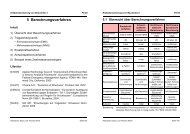JAHRESBERICHT - Institut für Baustatik und Konstruktion - ETH Zürich
JAHRESBERICHT - Institut für Baustatik und Konstruktion - ETH Zürich
JAHRESBERICHT - Institut für Baustatik und Konstruktion - ETH Zürich
Sie wollen auch ein ePaper? Erhöhen Sie die Reichweite Ihrer Titel.
YUMPU macht aus Druck-PDFs automatisch weboptimierte ePaper, die Google liebt.
LEHRE<br />
Master of Advanced Studies<br />
(MAS)<br />
Statistics and probability<br />
Faber, M.H. (HS 2009, FS 2010) 1. & 2.Sem. MAS<br />
Nr. 117-0101-00L<br />
2 G<br />
Nr. 117-0101-02L<br />
2 G<br />
Refresh the basic knowledge of the students in<br />
regard to statistics and probability with a special<br />
emphasis on the interrelationship between engineering<br />
model building; providing to the student with<br />
the basic <strong>und</strong>erstanding that the purpose of model<br />
building and the associated statistical and probabilistic<br />
representations is to provide a basis for decision<br />
making. Provide to the students the basic building<br />
blocks for time series analysis and statistical<br />
analysis of spatially varying phenomena such as<br />
extreme events of natural hazards (earthquakes,<br />
wind storms, avalanches and rock-fall) but also the<br />
random point in time variability associated with e.g.<br />
soil characteristics.<br />
Introduction<br />
Project work – Case study 1/2<br />
Faber, M.H. (HS 2009)<br />
1. Sem. MAS<br />
Nr. 117-0011-00L<br />
2 A<br />
Faber, M.H., (FS 2010, HS 2010) 3. & 4. Sem. MAS<br />
Nr. 117-0011-02L<br />
4 A<br />
Nr. 117-0013-01L<br />
2A<br />
Provide a context for the students such that they<br />
will always be able to relate the material they are<br />
taught during classes to the context of risk management<br />
from a conceptual, analytical and practical<br />
perspective.<br />
Provide a "portal" for the course outlining the role<br />
and relevance of the various course components.<br />
Put the course in perspective with regard to the<br />
operational and strategic aspects of risk management.<br />
Risk assessment<br />
Faber, M.H. (HS 2010)<br />
Nr. 117-0311-01L<br />
3. Sem. MAS<br />
2 G<br />
Master of Advanced Studies<br />
(MAS)<br />
ties in engineering models for both time-invariant and<br />
variant phenomena.<br />
Representing hierarchically, generically and by<br />
the use of indicators the components and their interrelationships<br />
for natural and engineered systems so<br />
as to facilitate a clear description of the exposures<br />
acting on the systems and how these exposures<br />
might generate both direct and indirect consequences<br />
for the system.<br />
Providing theories and methods for the representation<br />
and analysis of systems with the objective of<br />
analyzing and representing the evolution of consequences<br />
in space and time.<br />
How to assess and aggregate risks in large geographical<br />
regions.<br />
Damage to the built environment<br />
Vogel, T. (HS 2010)<br />
Nr. 117-0312-00L<br />
3. Sem. MAS<br />
1 G<br />
Providing knowledge of the basic concepts of the<br />
structural design of buildings (dwellings, office buildings,<br />
industrial buildings, public buildings), lifelines<br />
(bridges, galleries, tunnels) and special structures<br />
(power plants, dams, protective structures).<br />
Applying methods of vulnerability assessment<br />
that depend on the purpose of a structure.<br />
Consequence modeling<br />
Faber, M.H. (HS 2010)<br />
Nr. 117-0313-00L<br />
3. Sem. MAS<br />
2 G<br />
How to develop models for the quantification of<br />
loss of lives, economic losses and damage to the<br />
environment.<br />
How to differentiate between direct consequences<br />
and indirect consequences in a given problem<br />
context and how to assess societal and socially indirect<br />
consequences in dependency of the perceived<br />
direct consequences.<br />
Making use of data and engineering know-how to<br />
establish probabilistic models to represent uncertain-<br />
27


